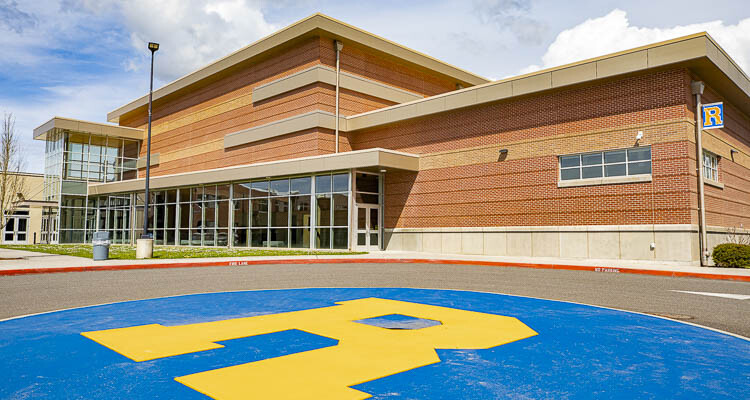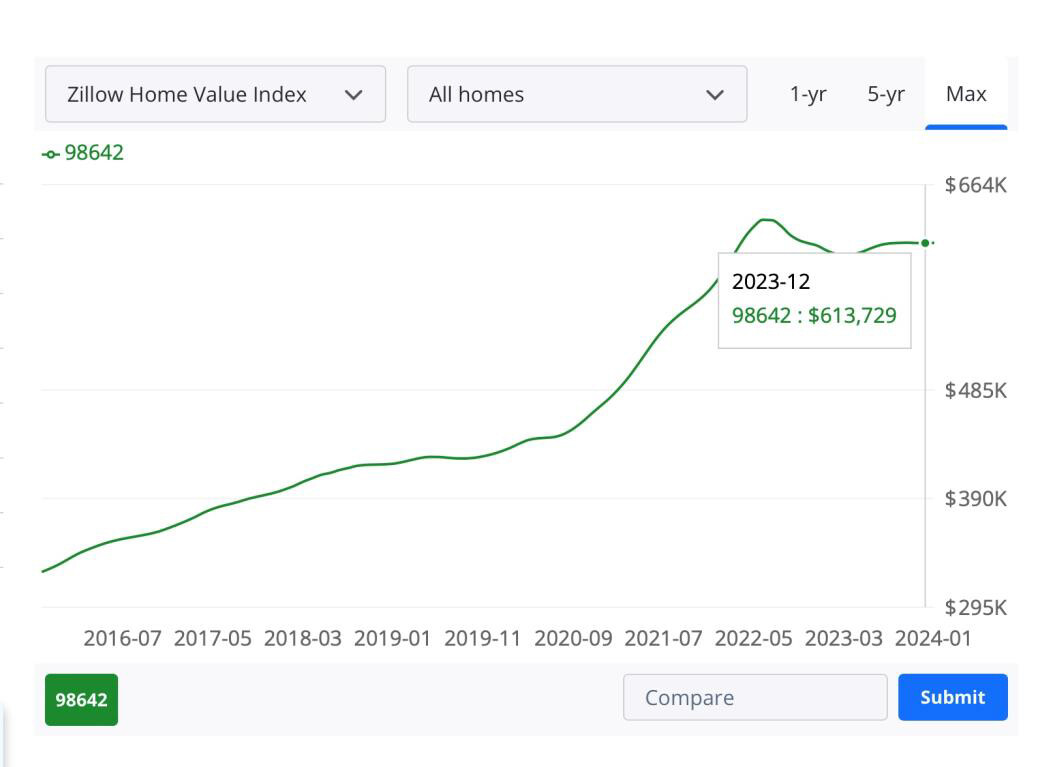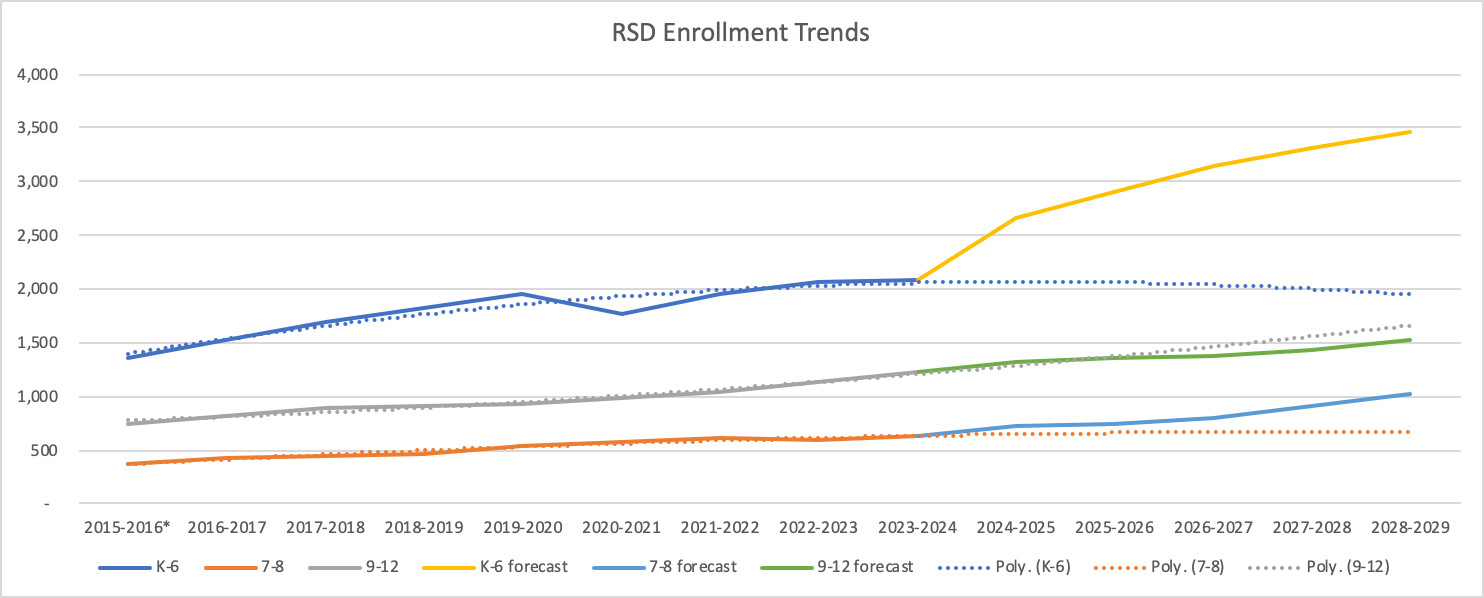
Heidi Pozzo states that in the Ridgefield School District, growth isn’t happening as fast as projected
Heidi Pozzo
for Clark County Today

If someone told you they were executing a plan in 2024 that was developed in 2015, you might think that a lot has changed since then. What if the Ridgefield School District was executing a plan right now to build schools without re-evaluating growth projections, composition, enrollment trends and downsizing by laying off teachers in other districts? And, making it worse, you were being asked to pay for that outdated plan.
What if they have it wrong?
There’s a typical approach to demographic planning for schools. It assumes people of a certain age have kids. Those kids grow up and start school in kindergarten then work their way up through high school when some kids drop out. And along the way people move in and out with kids of varying ages.
That’s how the projections look. Only the growth isn’t happening as fast as projected.

The orange line is actual enrollment as shown by Washington State Office of Superintendent of Public Instruction (OSPI). The light blue line is the forecast the district is using in their most recent publicly available plan.
The state of Washington and Clark County require public entities to develop a comprehensive plan including an inventory of existing facilities, a forecast of future needs, the proposed locations and capacities of expanded or new facilities, and at least a six-year financing plan.
The district historically satisfied this requirement through its Capital Facilities Plan. The last time the district completed the forecast future needs criteria of proposed locations and capacities of expanded or new facilities was in 2008. The 2015 and 2022 plans only included a mathematical calculation of students multiplied by a cost factor to get a dollar target for K-8 and high school.
In the meantime, there was a committee that developed a different plan in 2015 that was the basis for the new View Ridge/Sunset Ridge. Another committee developed the 2018 plan that called for a third K-4 school, expansion of general education class space of 400-500 at the high school, a remodel of the metal shop, along with playground and security updates.
Additional projects were identified and not prioritized and appear to have been grouped into an additional phase. Another document has projected phases and is directional, but does not have the specifics necessary to meet state and local requirements.
None of these projects have been detailed in the Capital Facilities Plan.
All of these plans were based on enrollment projections. But, what if something changed and actual enrollment is not following the projections? Wouldn’t that be a good indication that, at a minimum, change is needed if not an entirely new plan?
During the pandemic, three things happened. The median price of homes in the 98642 zip code that represents the district skyrocketed, growth rates of grade levels changed, and people started moving to Clark County from Oregon.
Here’s a snapshot of the median home price per Zillow on March 8, 2024. Big jump, right?

According to the State of Oregon:
In 2022, 77,400 Oregonians who were living in Clackamas, Multnomah, or Washington counties packed up and left the state. This represented 31,200 households. In total, 9,300 Portland area households moved north to Washington State (30% of all out-migrants), including 5,500 to Clark County specifically (18%).
And it’s not speculation to think that it is due to taxes (and a few other things). Multnomah County lost $117 million in income to Clark County between 2019 and 2020. Between 2020 and 2021, Multnomah County lost $1 billion in income as higher income residents moved away. Higher incomes are typically associated with people that have been in the workforce for some time or have retired.
Price spikes are typically driven by a supply and demand issue. So, it is not surprising that housing prices went up while people were moving across the river.
What we also know is that when the price of homes goes up younger people have a tougher time buying homes. The higher the home prices, the fewer young families. And that’s what started showing up in the data.
Over the last few years, since home prices have increased, K-6 has been leveling off. Populations are growing in 7th grade through high school. Given that we’d expect to see a net decline in population due to drop outs, the growth rate is noteworthy.
The following chart uses the same OSPI enrollment data as above, along with the 2022 Capital Facility Plan forecast data. Additionally, a polynomial trendline has been included to show that we should expect high school to trend up and the rest to flatten out.

Further, enrollment has been declining across the region and the state. This trend is unlikely to change as Washington’s birth rate dropped 22% between 2007 and 2022. The following shows enrollment declines with data from OSPI scorecards and Portland Public Schools.

It’s worth noting that Vancouver, Evergreen and Portland are all in the process of laying off hundreds of teachers and staff in an attempt to reduce budgets by a collective $85 million.
So, what does all this mean?
The risk of overbuilding in K-4 and 5-8 is high because the population demographics are changing. Yet, that’s where the district says the growth should be.
They’re recommending a K-4 and a 5-8 be built. Building a K-4 makes sense, but not the plan put forth by the district. Building a 5-8 does not make sense because the current school is just 96 students above capacity and the proposed plan is for a new 5-8 school for 1,000.
It’s actually the high school that has the highest growth rate. But the plans in this bond are not clear about how much general education capacity is being added. Nor is there any visible planning for the high school beyond this bond.
Executing a plan that was built on conditions from nearly a decade ago is fraught in normal times. But after having been through a pandemic and big changes across the river that have pushed people into the area, a fresh look at the plan is a necessity.
Given all these signals should Ridgefield take a step back and do a complete review and revise their capital plan rather than leave the public with hundreds of millions of dollars in debt? Voters will answer this question in April on a special ballot.
Heidi Pozzo has been a Ridgefield resident for 16 years. She is a concerned citizen who would like students to get a good education and thinks we can do it in a more cost-effective way.
Also read:
- Opinion: When bad policy fail real peopleAmy Harris says Vancouver’s failure to address street safety led to a fire that shut down a beloved immigrant-owned restaurant.
- Opinion: Fantasy math – Why the CBO’s numbers don’t add upNancy Churchill argues the CBO’s deficit math ignores key growth effects and revenue streams, calling its models misleading and politically biased.
- Opinion: Changes made — and not made — to WA Cares in 2025Elizabeth New (Hovde) outlines 2025 changes to WA Cares, including new automatic exemptions and eligibility tweaks. She also warns that exemption rules could shift, potentially forcing some private insurance holders back into the program.
- Letter: Can the president direct the U. S. Military to strike another country?Vancouver resident Jim McConnell questions the Constitutionality of presidential military actions without Congressional approval, citing historical precedents and legal opinions in response to President Trump’s 2025 strike on Iran.
- Letter: Social Security applauds passage of legislation providing historic tax relief for seniorsAnna Miller shares a letter celebrating new legislation that eliminates federal income taxes on Social Security benefits for nearly 90% of recipients. The bill also enhances deductions for seniors, fulfilling a key promise on retirement protection.










